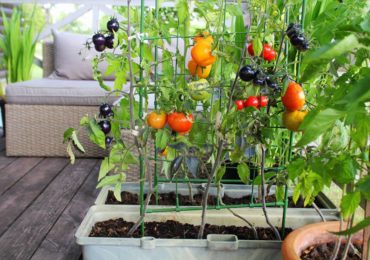 James H. Burdett did not address container growing in “The Victory Garden Manual,” but times were different in 1943. Today, growing edibles in containers is probably one of the fastest emerging trends. Plus, with vegetable breeders working on more compact varieties, your choices for what to grow in a confined space are countless.
James H. Burdett did not address container growing in “The Victory Garden Manual,” but times were different in 1943. Today, growing edibles in containers is probably one of the fastest emerging trends. Plus, with vegetable breeders working on more compact varieties, your choices for what to grow in a confined space are countless.
Ten tips for growing a container victory garden 2.0:
1. Don’t underestimate the size of container needed for growing some vegetables.
Bigger is almost always better, but with larger containers comes a need for more soil and thus weight becomes a consideration, especially if you plan to move your containers often. Drainage is very important in a container, as is soil depth.
For guidelines on choosing containers, read this article.
2. Just as with in-ground plantings, you need enough sunlight.
Containers need six to eight hours of sun per day to produce, but unlike in-ground plantings, you can move containers around to get more sunlight. Consider using containers with wheels, or otherwise easily movable containers, so they can receive enough sunlight.
3. What about wind? Are you on a corner balcony of a tall high-rise?
Think about how the wind might impact fragile plants or even topple the containers. Consider clusters of containers. Not only is it aesthetically pleasing, with plants providing some needed humidity for their neighbors, but also some plants can protect other plants from wind.
4. Vining crops need trellises.
With trellises, these crops not only get support but can also grow upwards, saving horizontal space that might be at a premium.
5. Soilless potting mixes are great for containers, providing good drainage with less weight.
With soilless mixes, there less chance of soil compaction. The larger the container, the more potting mix you’ll need, which means less frequent watering.
6. Consider drip irrigation or self-watering containers.
This would depend on your availability to water frequently enough. Container gardens do require more frequent watering (sometimes multiple times each day if it’s hot and dry) than in-ground plantings.
7. Proper fertilization is more important for container plantings.
More frequent watering can wash out some of the nutrients a plant needs to produce vegetables.
8. Know your zone and know your last frost date.
This is the same as with in-ground plantings. Without that knowledge, you are setting yourself up for disappointment.
9. Think combinations.
Why not plant basil with a tomato plant? Or put beans with carrots? Spinach and onions work well together too. Some vegetables are pretty enough to be front and center and act like ornamentals.
To make it even easier, many suppliers and garden centers have options for varieties that grow well in containers.
10. Don’t forget the pollinators.
Last but not least, make sure to plant some flowers for the pollinators. Flowers that attract bees are good and necessary no matter how or where you plant your vegetable garden.























